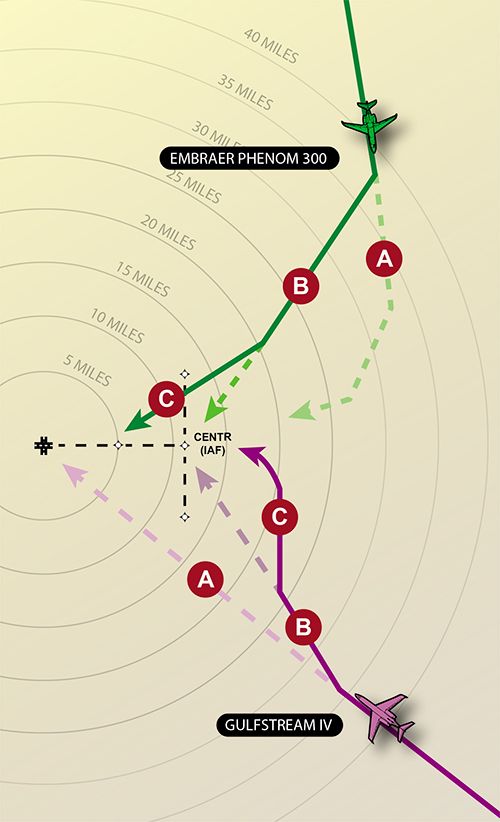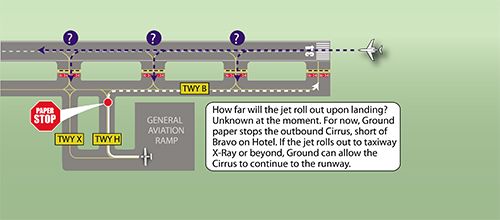
Information is the foundation on which air traffic control is built. Controllers absorb tons of data as we work our traffic—winds and weather conditions, advertised runways, aircraft types, filed routes, NOTAMs. The list goes on. We take all this data and use it to build sequences for arrivals and departures, and keep aircraft safely separated.
Sometimes, though, we’re missing a key piece of information. Perhaps we’re waiting on something from an aircraft, like a turn or an IFR cancellation. Maybe we’re gauging how the winds aloft impact our traffic’s speeds before we build a sequence. Until those gaps in our traffic picture get filled, we can’t follow through all the way on many tasks.
That doesn’t mean we adopt the all-or-nothing approach and just sit on our hands until every single piece falls into place. Heck, no. Instead, we rely on interim instructions that take us right to the edge of our uncertainty, but no further, to keep our traffic moving in the right direction and separated.
Bit by Bit
Imagine you’re at 8000 feet on a heading of 180, and I—your controller today—need to descend you to 2000 feet on a heading of 130. However, there’s some traffic maneuvering due south of you at 3500 feet. I don’t know how long it will take you to turn or descend, so I tell you, “Fly heading 130. Descend and maintain 5000.”
In your cockpit, you’re putting in the effort, pushing the nose over or setting George to take you down to 5000. Well, truthfully… I never intended for you to actually stop at 5000. I want you to go all the way to 2000. However, until I can verify your new heading avoids the traffic, I’m putting a temporary limit on your descent. I’m protecting for that unknown.
If I descended you to 2000 but you took your time making the turn, and ended up getting close to the other aircraft, then it’s my fault. Instead, I watch you turn and ensure the spacing will exist. When everything looks good, well before you even get near 5000, I’ll say, “Descend and maintain 2000.”
The 5000 foot assignment is called, in ATC parlance, a “paper stop.” It’s not carved in stone or engraved in steel for all eternity. It exists, as the saying goes, only on paper. The second the ATC instruction is not relevant, it gets mentally crumpled up and discarded and replaced with the preferred instructions.
Now you must dial in the 2000 foot altitude. I made you do twice the actions, adding a bit to your workload in the already-busy descent and approach phase of your flight. It’s too bad you couldn’t have just descended to 2000 from the get-go.
I want to stress this: fleeting as it was, that original descent to 5000 wasn’t an idle suggestion. It was a legitimate ATC instruction and must be followed per the AIM. If I had said nothing afterwards—for instance, if I noticed the traffic was going to be a factor—you would have been expected to level off at 5000.
Could I have used the following conditional instruction instead? “Traffic, twelve o’clock, eight miles, 3500 feet, maneuvering. Turn left heading 130, descend and maintain 5000. Once established on that heading, descend and maintain 2000.” Absolutely, but that opens up the door to a lot of confusion, and when I’m busy I don’t have time to repeat or explain myself. Paper stops effectively provide temporary safety buffers using simple instructions and no conditions.

Common Ground
The concept of paper stops applies to many controller tasks. One common technique for building sequences is sending aircraft direct to a fix on an approach. This lets us judge how soon he’ll get there.
Imagine I have two jets—an Embraer Phenom 300 and a Gulfstream VI—inbound to a particular airport. Both are 40 miles from the destination airport, assigned 250 knots. The Phenom is on a STAR (standard terminal arrival) that winds him around a bit, but he’s got a tailwind pushing him. The Gulfstream was cleared direct to the field, but he’s flying into the wind, cutting his ground speed substantially.
Which will be first? Right now, it might be difficult to tell. There are so many variables in play—aircraft performance, winds aloft that differ by altitude, assigned routings, airspace considerations. With all these variables, it’s important to find common ground upon which to build that sequence.
To find that commonality, I send both aircraft direct to the CENTR initial approach fix (IAF) for the active runway’s RNAV approach. Since they’ll eventually converge over that fix, I also assign them different altitudes to ensure vertical separation, maintaining positive control. With visuals in use today, my intent isn’t to make these planes fly the approach. The fix is simply the “paper stop.” Neither airplane will likely get a chance to overfly it. I’m just aiming them at it for now, until I can decide who’s going to be number one.
Of course, this requires you to load up the proper approach and get it set up in your system, i.e. more work for the flight crew. Why not just assign a heading? Airplanes on headings can still be blown about by the wind. A 20-30 degree variation over 40 flying miles can make a heck of a difference in a sequence or avoiding someone else’s airspace. By using the fix, the winds aloft will still affect ground speed, but each aircraft’s track across the ground will be predictable and consistent.
As they close on the airport, I note the Gulfstream is 13 miles from the fix, while the Phenom is only 10 miles. With this observation, I make a decision: the Phenom is number one. I descend him, keep his speed up, and now vector him towards a five mile final instead of the IAF. I slow down the Gulfstream, and give him a quick vector to follow. Neither aircraft actually touched the IAF, but sending them there initially allowed me to gauge who was going to be the lead.
Hold This for Me
One place you’ll find paper stops fairly often is in non-towered airport operations. In this scenario, I have two IFR aircraft inbound to a non-towered airport. The first one is only 10 miles out and gets the airport in sight. I clear him for the visual and change him to advisory frequency. He already has the frequency or phone number to call to cancel his IFR clearance.
What about #2? He’s 20 miles out. Due to ATC’s one in/one out requirements for non-towered airports, he can’t be cleared for an approach to that airport until #1 cancels IFR. What are my options? I can give him delay vectors and speed reductions to build time. However, that’s potentially introducing many transmissions and a whole lot of watching on my end to ensure he doesn’t wander too far from the field.
What’s a cleaner solution that takes care of both turns and speeds in one shot, and keeps him close to the airport? The RNAV approach into this airport has a published hold/procedure turn on its center IAF. “Awaiting IFR cancellation from preceding aircraft. Proceed direct [fix]. Hold north of [fix] as published. Maintain 3000. Expect further clearance time [hh:mm] Zulu. Time now [hh:mm].”
Now, both #2 and I are hoping that #1 cancels IFR in the air. Unfortunately, we can’t bank on that. Some pilots wait until they’re on the ground before cancelling. Some cancel via Flight Service. Infuriatingly, some forget to cancel entirely, and ATC is forced to track them via FBO phone numbers or even law enforcement. Right now, we can do nothing but wait.
This means that, unless told otherwise, pilot of #2 must still go through all the appropriate procedures: briefing the hold, tuning in appropriate navaid frequencies, getting it loaded up in his system, etc. This is not a fake instruction. There’s a real chance he’s actually going to be holding.
Thankfully, as #2 is nearing the holding fix, I receive #1’s cancellation. Let’s tear up that paper stop. “Disregard the hold,” I say to #2. “Proceed direct to the airport, descend and maintain 2000. Airport 12 o’clock, 11 miles.” Soon he’s cleared for his visual approach. Was all that holding stuff wasted effort? No. Had #1 not cancelled, #2 would have been in a safe, predictable spot, ready to drop into the airport whenever the opportunity came around.
Want to have some real fun with paper stops? Get a helicopter involved. At one of my previous towers, we worked a lot of helicopter traffic. They shot numerous practice instrument approaches to both of our intersecting runways, 9/27 and 18/36. Normally, we’d just clear them for a low approach.
However, if a helo was closing in on final for, say, Runway 9 and we wanted to depart a jet off Runway 36, we couldn’t clear the helo for a low approach to 9 and clear the jet for takeoff on 36. When we clear an airplane for takeoff or someone for a low approach, we give them all the runway in front of them. If the helo crossed the Runway 9 threshold for a low approach while the jet was rolling on the intersecting Runway 36, that’s an operational error. Big trouble for ATC.
One option would be to make the jet wait for the helo. Well, helos tend to be slow—no offense, rotary-wing wranglers—and the jet could be waiting a while. We don’t want to create long delays either.
Enter a paper stop. Unlike fixed wing airplanes, helicopters can be instructed to land on a specific point. Choose a landing point short of the crossing runway—like the runway numbers themselves—and we’ve got the separation we need. So, I’d tell the helicopter, “Unable low approach. Jet traffic departing Runway 36. Runway 9, on the numbers, cleared to land.” Bam. He’s no longer getting the whole Runway 9, just the arrival end part painted with the big “9.”
I’d then tell the jet, “Helicopter traffic landing on the numbers of Runway 9, holding short of your runway. Runway 36, cleared for takeoff.” There. Now both know about each other and what each other is doing. The jet can take all the time in the world, and he and the helicopter will still be safely separated.
The jet rolls. Did he go quick and get through the intersection of both runways while the helicopter still had a little distance to fly? I’d go back and change the helo’s clearance: “Traffic no factor. Runway 9, cleared low approach.” Of course, if the helicopter was over the runway threshold, in a critical phase of flight and about to touch down—or the jet hadn’t gone through the intersection yet—I would let him land. After the helo had safely settled and any conflicts were resolved, I’d clear him for takeoff and send him on his way. —TK
Stopped Short
What about airplanes at speeds in the tens or even single digits of knots? I’m of course talking about ground movement. Paper stops apply there too, as we protect for the unknown.
Controllers are always coming up with plans. Take arrivals. I must have a plan in place to get a landing aircraft off the runway to its ramp or gate. However, I have no idea how long each aircraft will roll out before exiting the runway. Sure, I can take a guess based on aircraft types, but when you make assumptions, you get bitten. I’ve seen Boeing 757s touchdown and exit the runway in under 3000 feet, and Beechcraft Bonanzas take up every inch of an 8000 foot runway. You just never know.
How about outbound flights calling for taxi? How long before they actually get underway? Immediately? A minute? Two? Three? I’m not in their cockpit, following procedures. I don’t know.
Also, how fast will they actually taxi? Normally, airliners taxi quick, up to 20-30 knots on straightaways. Others … well, one airline’s pilots were in contentious wage talks with their management. These pilots, apparently spiting their company’s on-time performance for leverage, would use the oft-cited “brisk walking pace” standard—a couple miles per hour or so. It’s perfectly legal, but to travel the length of a mile-long runway, that’s a taxi time of 15-20 minutes. Until they actually started moving, we had no idea what kind of situation we were facing, and would then have to run our other traffic around them.
To ensure good flow—and prevent a controller from earning a legendary “golden towbar award” by having two aircraft stuck nose-to-nose—we use paper stops. Imagine our Runway 34 is paralleled by a single taxiway called Bravo. I’ve got a jet on final. A Cirrus SR22 calls for taxi. His best route would be a connecting taxiway, Hotel, then Bravo to the end of Runway 34. Plus, I’ve got a pile of other planes on frequency.
How fast will the Cirrus taxi? Will the landing jet roll past or get off before Hotel? I dunno. So, I tell the SR22, “Runway 34, taxi via Hotel. Hold short of Bravo.” There. Regardless of the SR22’s taxi speed, other traffic distracting me, or where the jet exits the runway, the SR22 and jet’s paths won’t meet. The jet ends up rolling long, past Hotel, so I amend the SR22’s taxi: “Runway 34, continue taxi via Bravo.”
All these techniques have the unfortunate side effects of adding workload to pilots and increasing frequency congestion. However, there is a good trade off: ensuring aircraft remain safe and organized when controllers don’t have all the information at hand.





I loved this article. A great read on what we sometimes get, but don’t always understand the reasoning.
Great insights by sharing your perspective, thank you very much for that article!
Great article, Gives up a really good look into the practical workings of ATC control and separation. As mentioned by the authur paper stops increase workload for the pilot which benifits separation, by increaseing workload for the pilot it also introduces more risks of inattention to flying the aircraft and pilot induced errors espcially for single pilot ifr. Especially for those without an autopilot. It would be great for those controllers that are not pilots to see what pilots go through on an ifr approach in imc or even just flying the approach vfr for them to observe the workload with several changes in clearance. I offer the controllers in my area flights just for that benifit.